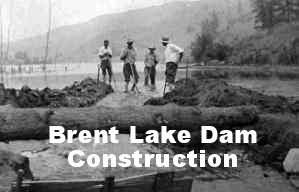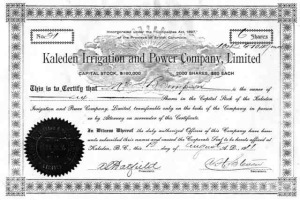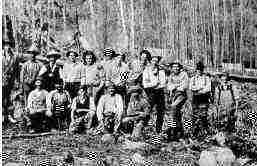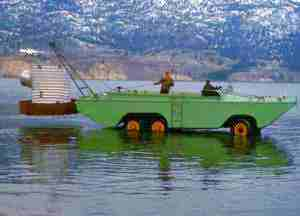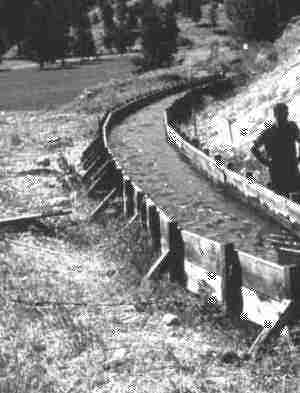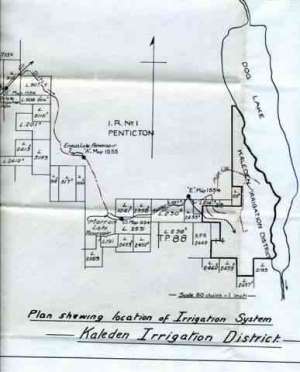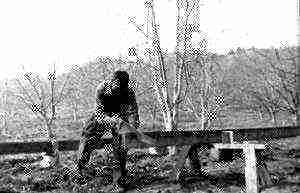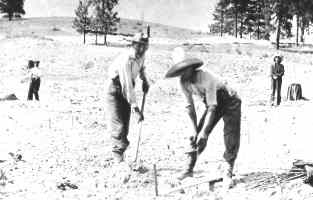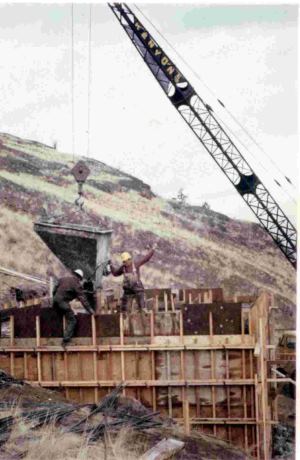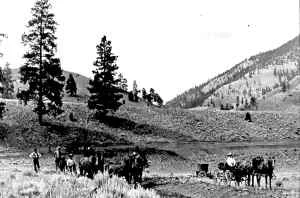In 1905, James Ritchie, the developer of West Summerland, was searching for new opportunities in the south Okanagan. Ritchie looked across the parched hills on the western shore of Skaha Lake and visualized orchards that could materialize if water was supplied. Over the next year he and family members purchased some 3,000 acres and by 1908 plans for subdividing and construction of an irrigation system were well underway. In the spring of 1909 this new development was named “Kaleden”.
Thirty five prospective buyers deposited a sum of $50 with Mr. Ritchie for each 5 acre blocks they wished to purchase, which were sold on a first come first serve basis. From that point on, lots were sold for $240 per acre plus the cost of water shares at $80 an acre, raising the cost from $50 to $1800 for a 5 acre block.
Mr. Ritchie promoted the Kaleden Development Company, with its capital chiefly being obtained in England. The matter of guaranteeing water for thirsty land was the crux of the whole development and the largest task was construction of an irrigation system capable of meeting the needs of the area. Water rights were obtained from Shatford and Sheep Creeks and the first stage of the water system was started in 1908. Water was taken from Shatford Creek by means of a diversion dam and crossed the valley at Allen Grove through an inverted siphon of 24” wood stave pipe. From that point it was conducted by ditch and wooden flume to a place on Marron Creek, 1 1/2 miles west of the junctions of Highways 3 and 97, where a concrete intake was built. Because of the hilly nature of Kaleden below the intake, ditches and flumes could not be used. The alternative was a system of pipes for distribution- more expensive, but it gave Kaleden a year round water supply where neighboring communities had to store their winter supply in cisterns.
The pipe used was made of douglas fir staves, wound with heavy tempered steel wire and covered with pitch and two layers of burlap. This pipe was built to withstand 300 pounds pressure and varied in diameter from 2 to 18 inches. Some of the original pipe lasted for over 30 years before being replaced. Remnants still exist in the community today.
Tom McAlpine was brought in by Ritchie in the spring of 1909 and placed in charge of all construction. He spent most of his time overseeing the work from Shatford Creek to the intake and placed Harry Corbett in charge of 20 men to dig ditches in Kaleden in preparation for pipe laying the following spring. Most of the workers were recruited from the Penticton Indian Band.
The work was pushed ahead so planting could be done the following spring. One of the pieces of construction completed that fall of 1909 was a concrete lined ditch at the north end of Marron Valley designed to prevent the soil washing down steep slopes. This was one of the first pieces of concrete irrigation ditch built in the Okanagan Valley.
The first system serviced about the same area that the present Irrigation District covers, but was intended for a larger area. In 1911, a branch line was started to supply water to Gillespie Flats. With this in mind a cumbersome and antiquated ditch digger was purchased to replace hand dig trenches. However, it proved to be useless for the job and this coupled with a lack of funds and the uncertainty as to an adequate supply of water brought this extension to a halt at Junction Ranch. As a result, a planned Gillespie subdivision of 618 acres was abandoned.
There were many changes and addition to the water system over the ensuing years. The old Gillespie earth dam at Marron Lake was reinforced and a new dam with a cement core was erected at Aaneas Lake in 1912.
During the development period from 1911 to 1916 no tolls or taxes were levied on the area planted. By 1916, when approximately 1/3 of the planted area had been sold to private individuals, it was realized that funds had to be raised for the maintenance of the irrigation system and the Water Rights branch authorized a tax levy of $2.00 per acre.
From 1916 to 1922 the orchards suffered considerably from lack of care and attention. Labour during World War 1 was extremely short and further funds were not available from London. During this period trees planted over approximately 300 acres died out.
In 1922 Sir William Hutchison Poe acquired all the lands granted to the Kaleden development Corporation with the exception of approximately 200 acres purchased by private individuals. At that time, Kaleden under the provisions of the Water Act was constituted an improvement district. The first trustees of the Kaleden Irrigation District were Col. Ewart, Frank Harrison, F.W. King, R.D. Mutch and H. W. Corbitt.
An agreement was reached between Sir William and the Improvement District to the effect that Sir William would expend the sum of $31,300 on repairs and renewals to the existing irrigation system. In 1922, Robertson and Partners were awarded the contract to replace the old earth dam at Marron Lake with one having a concrete core, increasing the height from 5 to 25 feet.
In return for this expenditure the Improvement District undertook to refund a portion of this sum by the issuance of 30 serial debentures payable without interest each year from 1922 until 1951 inclusive.
To provide for the redemption of the debentures the district was authorized to levy an additional tax of $4.00 per acre on approximately 200 acres classified as grade A lands, over and above the tax of $8.00 an acre on other land.
By 1931 the orchards were in full bearing and it became evident that Shatford Creek could not be counted on for an adequate supply of water. Consequently the system was extended by diverting water from Shingle Creek and erecting two dams to form upper and lower Brent Lake. Interior Contracting Company completed the work in 1932, providing and increase of 1,000 acre feet.
Unfortunately the whole quantity of water was not available to the Kaleden Irrigation District. In exchange for rights of way, the District undertook to supply and convey to property owners along the route over which the system was installed , approximately 1014 acre feet of water for which no tax was levied, with the exception of one isolated case where a small and inadequate levy was made.
In 1950’s the system had deteriorated to the point where replacement of certain sections became essential. The cost of maintenance exceeded the revenue obtained from taxation and the sale of lands. Loans totaling $57,000 were obtained from the provincial government through the Water Rights Branch, which enabled the District to replace the siphon at Allen grove, 1000 feet of wood flume, excavation of a channel to replace 1700 feet of wood flume and 4876 feet of wood pipe along the south main in Kaleden.
The system extended over 12 miles from Shingle Creek to the intake at Marron Creek and included flumes and ditches. From the intake into Kaleden and including the distribution mains, there were approximately 10 miles of piping.
The next change in the system was in the orchards themselves, when in 1949 the sprinkler replaced the old furrow method of irrigation. As Kaleden has always had a pressure water system, the change was easily made and in the 1960’s over 90% of the orchards had adopted this method.
Jim Harrison and Hartley Simpson were the first water foremen for the upper system while N. K. Simpson served in that capacity in Kaleden, followed by Tosh Rawkins and Jack Swales, the latter serving for over 20 years.
On September 13, 1963 the general meeting of Kaleden ratepayers elected to proceed with a program to rehabilitate the gravity irrigation system with ARDA (Agricultural………. ) assistance. In June of the following year the decision changed to convert to a pumping system. Work proceeded to install a pumphouse on Skaha Lake consisting of four units totaling 725 HP, capable of pumping 5 ¾ million gallons per day over a total of 535 acres.
Laying of 35,300 feet of new distribution mains began on April 1, 1965 and the construction of the intake line commenced the following January. The new irrigation system was officially opened by the Honorable Frank Richter on 30 June 1966.
Excerpts taken from “History and Development of the Kaleden Irrigation System” by W.E. Lane, Secretary Treasurer of the Kaleden Irrigation District (1957) and “The History of Kaleden” by H.W. Corbitt (1967/1971)
